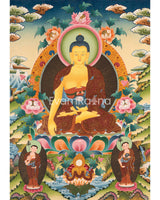


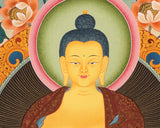
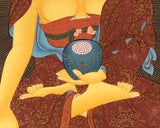
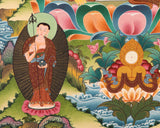
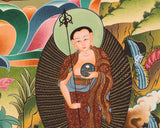

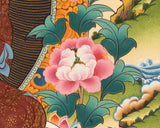

Traditional Shakyamuni Buddha | Buddhist Thangka Painting

100% AUTHENTIC

HANDPAINTED

FREE SHIPPING
Traditional Shakyamuni Buddha
About to the Thangka
Amoghasiddhi is associated with Vajrayana Buddhism and originates in the Tantric Literature of the Charya, Yoga, and Anuttarayoga Tantra classes. The sculptural images generally fall into two groups, either as Buddhas with monastic robes and without ornaments known as nirmanakaya appearance or Buddhas in Bodhisattva Appearance, also known as peaceful appearance, with crowns and ornaments - sambhogakaya appearance. He is most commonly depicted in the set of the Buddhas.
Introduction To Thangka
Gautam Buddha, also often referred to as Sakyumuni, was a spiritual teacher upon whose lessons the foundations for Buddhism were formed. He is regarded as the Supreme Buddha and is the first enlightened individual to be visualized. Despite some confusion from those who do not follow Buddhism, it is important to note that the Buddha was not considered to be a God. He was rather a mere human, like the rest of us, who was able to develop an extraordinary perception about existence. This perception helped him to rid his mind of the things that cause us all a level of suffering; craving, hatred, and delusion. This, in turn, helped him to attain levels of true peace and contentment – and remain free from the suffering of sentient beings.
How does Thangka benefit us?
It goes without saying that every detail of a painting has a symbolic meaning. Regardless of your religious affiliation, a thangka can help you on your path to enlightenment, whether you practice Buddhism or have other religious convictions. Thangkas are paintings that depict deities with various iconographic elements and symbolism that encourage meditation on the teachings of the god they depict. Any thangka is intended to aid in the removal of the film of ignorance, which is a significant barrier to the road to enlightenment.
How to Take Care of Your Thangka?
- Hang your thangka in a traditional silk brocade.
- Regularly inspect your thangka; examine the borders and all attachments.
- Keep thangkas covered when they are on display but not in use.
- Rotate thangkas between display and storage two to four times a year to reduce exposure to light. Keep them away from sunlight and humidity.
- Do not apply liquids or other materials to the surface of the thangka.




















